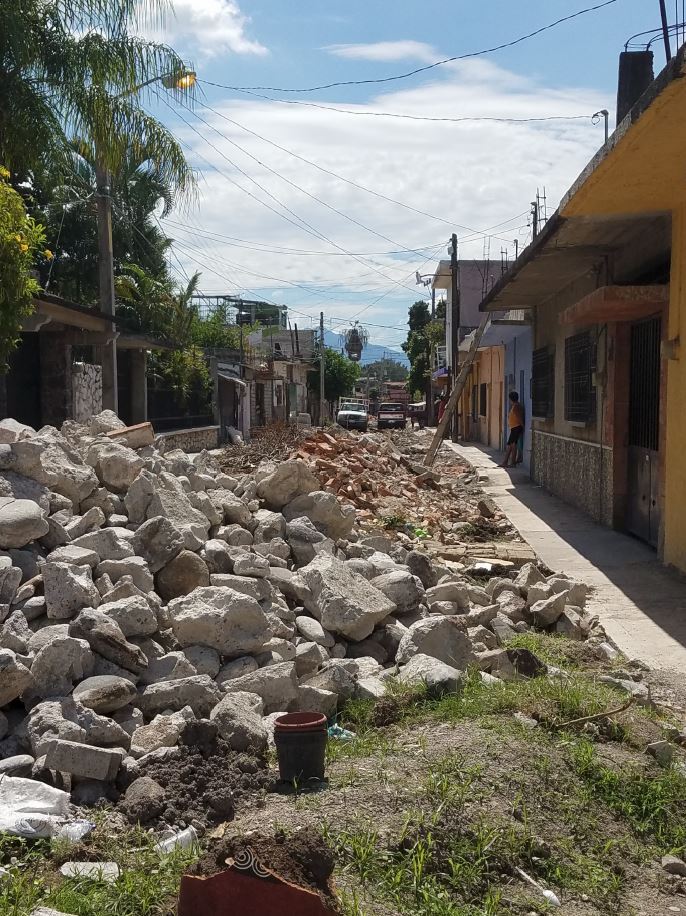By David Jacobson, Temblor

Three weeks ago, a Structural Engineers Association of Southern California (SEAOSC) sent its Safer Cities Reconnaissance Team to Mexico City to inspect damage sustained during the 19 September 2017 M=7.1 Puebla earthquake, and to learn how the earthquake dislocation was percolating throughout affected communities. Their goal was to determine how lessons learned in Mexico could be applied to communities and cities in the U.S.. We spoke to two team members, Daniel Zepeda and Ken O’Dell, to gain firsthand knowledge of this reconnaissance trip.
The most damaging Mexico shock since 1985
As a bit of a refresher, the M=7.1 Puebla earthquake on September 19, 2017 was the second large earthquake in a flurry of quakes that hit Mexico in a matter of weeks. While 30 times smaller than the 7 September M=8.1 Chiapas earthquake 600 km (350 mi) to the southwest, Puebla earthquake’s proximity to Mexico City meant that it was the most devastating quake to hit the country since 1985.
Daniel Zepeda said that “while any reconnaissance team can learn a lot from examining collapsed buildings, one of the main purposes of this team was to look at the earthquake from a community perspective.” By seeing how things were handled, the team could gain a greater understanding of needs prior to and following an earthquake, and apply this to earthquake preparation here in the United States.
Red tag rampage
Perhaps their most striking observation was that the lack of governmental resources can put thousands in limbo. This was especially clear in building tagging. In the aftermath of the earthquake, thousands of buildings had to be inspected and given a tag designating them as safe (green) or not (yellow or red). In Mexico, this authority is vested in the government. Unfortunately, thousands of buildings had to be given a ‘conservative’ (red or yellow) preliminary tag before investigations could be carried out. This resulted in people being forced to find other places to live or work, while the state of their building remained—or still remains—unknown. Witnessing thousands of people living on the street waiting to learn the fate of their building led Ken O’Dell to wonder if we have enough trained inspectors and inspection resources in the U.S., and how well we will respond. For example, in a large California earthquake, do you keep people in uninspected buildings and risk their safety, or do you remove and displace tens of thousands, who will then need immediate, and for some, longterm, housing.

The wisdom of Building Retrofit Ordinances
One way to alleviate this potential problem is through building ordinances. Daniel Zepeda said that buildings which performed poorly in the M=7.1 Puebla earthquake all showed similar deficiencies, most notably, soft stories or structures made of non-ductile concrete. “The buildings that performed poorly are known to perform poorly, and you can do things to prevent what happened,” he said. In California, several cities, including San Francisco, Los Angeles, and Santa Monica, have instituted mandatory retrofit programs for similar at-risk buildings. But people are fearful of ordinances, and often mistrust the intentions of the municipalities that adopt them. O’Dell argues that the key to overcoming these obstacles is communication: Building owners need to know that the primary goal of ordinances is safety, and that the experience of Mexico City—both n 1985 and 2017—illustrates that the measures we can take now can prevent tragedies from happening again.
The challenge of restarting your life after the quake
Both team members we spoke with also stressed the importance of communication at the community level. In Mexico City, Ken O’Dell saw that there was a significant level of disconnect between what community members expected to happen following the earthquake versus how things actually happen. Such disconnect led to community members now knowing how to go from the ‘I survived’ stage, to the ‘What now?’ stage.
Earthquake awareness is not enough
One of the ironies of the chaos and dislocation enveloping some areas of Mexico City is that earthquake awareness there is higher than in California. And so, the preparations should be better, but arguably were not. Resilient communities can only arise through communicating the importance of retrofitting at-risk structures or providing a greater understanding of the recovery process to small communities to aid in emergency response. We should all do what we can to minimize the potential impacts large earthquakes have on the fabric of our communities, and not just to their buildings.

SEAOSC Strengthening our Cities Summit in Los Angeles on Nov 7-8
The Recon Team will highlight their findings at the SEAOSC Resilient Cities Summit during the Nov 8 luncheon. Temblor’s Ross Stein will also talk in the same luncheon about whether the 16-days of M=8.1, M=7.1, and M=6.1 Mexico quakes were a chain reaction or coincidence, and about the limitations on the warning times of Earthquake Early Warning systems in Mexico and the U.S.
Temblor will also have a booth at the Summit.
- Beware quiet segments of the Philippine Fault - May 16, 2025
-
ډیری عوامل افغاني ټولنې د زلزلې پر وړاندې زیانمنوي
- August 11, 2022 - What’s happening this week in Humboldt County, California: The squeeze - February 6, 2019
